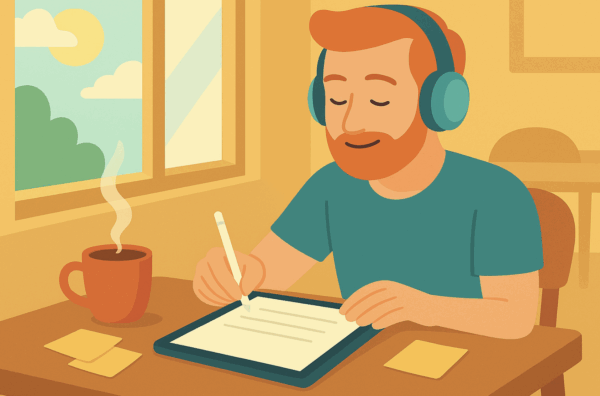Writing dialogue is like hosting a party where your characters are the guests. Some are the life of the party, cracking jokes and commanding attention, while others hang back, quietly sipping their drink, offering the occasional one-liner. Great dialogue isn’t just about what characters say—it’s about how they say it, and why they say it at all. After all, how your characters speak can reveal everything from their past experiences to their deepest secrets, all while keeping your readers hooked.
If you’ve ever read a book and found yourself thinking, “Wow, I can totally imagine what this character would sound like,” then you’ve experienced the power of distinct voices in dialogue. The way a character speaks can set them apart, develop their personality, and propel their story forward. This article will break down exactly how to write dialogue that feels natural and authentic, with a special focus on giving each character their own unique voice. From mastering dialogue tags to avoiding the dreaded bad dialogue, we’ll help you craft conversations that feel as real as the ones you overhear at your local café—without the awkward silences. Ready to get your characters talking? Let’s get going!
How to Write Dialogue: A Brief Overview
Writing dialogue is like balancing on a tightrope. Too little and your characters come across as flat; too much and your story starts to resemble a never-ending conversation at a coffee shop. The key is to find that sweet spot where every word serves a purpose: revealing character, advancing the plot, or adding a little tension to keep readers on the edge of their seats.
At its core, writing dialogue is about reflecting the way people speak in real life—but with a little more finesse. In real life, we tend to ramble, repeat ourselves, or throw in a lot of “um” and “like.” But in a story, every line should be meaningful. Dialogue is more than just chatter; it’s a tool to build your characters, push the plot forward, and, most importantly, keep readers engaged.
The magic happens when dialogue isn’t just words on the page—it’s the person speaking through those words. In the next sections, we’ll break down how to write realistic dialogue that doesn’t sound like a lecture or an awkward, forced exchange. We’ll also tackle the all-important question: how do you make sure each character sounds like themselves? Spoiler alert: It’s not just about their accent (though, yes, that can help). Stay tuned for tips on making your characters’ voices as memorable as their actions.
Understanding Character Voices: What Makes Them Unique
When it comes to writing dialogue, one of the most powerful tools at your disposal is the character’s voice. And no, we’re not talking about whether they have a baritone or sound like they’ve been gargling gravel. A character’s voice is about their personality, their background, and how they view the world. It’s the sum of their experiences, their speech patterns, and their choice of words. Essentially, it’s how they speak, and more importantly, why they speak the way they do.
Just like you would never mistake the way your best friend talks for the way a professor at a university would speak, your characters should also sound distinct from one another. Think about it—would a hardened detective use the same language as a bubbly high school student? Of course not. By tailoring your character’s dialogue to match their unique voice, you’ll add layers to their personality and make them feel more authentic.
Here are some ways to help craft those distinct voices:
- Speech Patterns and Pacing: Some characters might speak in short, clipped sentences that convey urgency or seriousness. Others might be more loquacious, taking their time to elaborate on every point. These sentence structures reveal a lot about their inner monologue and attitude toward the world around them.
- Colloquialisms and Slang: Does your character throw around phrases like “y’all” or “innit”? Regional slang or dialects can be a fantastic tool to give your characters an extra layer of authenticity. But beware of overdoing it—too much can make it hard for your readers to follow, especially if you’re writing in a genre like literary fiction where clarity is key.
- Formality vs. Informality: The way a character speaks often reflects their social standing or personality. A corporate CEO might use more formal language and avoid contractions, while a street-smart character might opt for more casual, direct speech. Character dynamics come through not just in what is said, but how it’s said.
Each of these elements should serve as a clue to who your character is. When done correctly, it’s like giving your readers an instant insight into the character’s world—without needing to explain it in a tedious backstory.
By focusing on your characters’ unique ways of speaking, you’re laying the foundation for realistic dialogue that speaks volumes without needing to shout. So next time you write, ask yourself: How would this character speak in this situation? And remember, the beauty of good dialogue lies in the details!
Writing Dialogue: Keeping it Real and Relatable
When it comes to writing dialogue, one of the golden rules is making sure it feels real—but with a twist. In real life, conversations often meander, include interruptions and sometimes end with awkward pauses. While these moments can add flavor to an interaction, they don’t always serve the story. The trick is to capture the essence of how people speak without bogging down the narrative in endless, meandering chit-chat.
Realistic dialogue has a rhythm that mirrors the way people talk, but it’s streamlined and purposeful. Imagine overhearing a conversation in a café. While it may be full of personal anecdotes or casual remarks, it’s still organized enough that you can follow the thread of the conversation. Your goal as a writer is to recreate that sense of natural flow, but without bogging down the reader in too many details.
So, how do you make sure your dialogue is relatable while avoiding the trap of bad dialogue? Here are a few tips:
- Avoid Too Much Small Talk: People don’t always talk in platitudes or idle chatter, and neither should your characters. Small talk can work in specific situations—say, a casual greeting or a transitional moment—but if it dominates the scene, it can slow down the pace. The key is to make sure every piece of dialogue either reveals something about the character or advances the plot.
- Don’t Over-explain: We’ve all had those awkward conversations where a person repeats themselves for clarity or over-justifies their point. As tempting as it might be to “explain” everything your character is thinking, it can make your dialogue feel stilted. Let your characters show, not tell, through their speech. And remember, real dialogue doesn’t always explain everything—it leaves room for interpretation, mystery, and emotional depth.
- Action Beats and Body Language: Conversations are rarely just about words. People gesture, fidget, roll their eyes and shift their posture as they speak. Adding these action beats helps break up the dialogue, keeps things visually dynamic, and reinforces a character’s emotional state. A simple line like, “He muttered, running a hand through his hair,” can say a lot more than dialogue alone ever could.
- Use Pauses and Silence Wisely: Just like in real life, silence can speak volumes. A moment of hesitation, an uncomfortable pause, or a character who trails off can add tension and complexity to a scene. Don’t be afraid of silence—it’s an essential tool in crafting compelling dialogue.
Ultimately, the best dialogue feels like something you’d hear in real life, but with the extra polish that comes from careful editing and a solid understanding of your characters. Keep it natural, but make sure it serves a greater purpose in your narrative. In the next section, we’ll dive into dialogue tags and how they can help make your dialogue even more effective.
Dialogue Tags: Beyond “Said”
Ah, the trusty dialogue tag. Every time a character opens their mouth, you need to let the reader know who’s speaking. Most of the time, “said” does the job just fine. It’s invisible, unobtrusive, and lets the dialogue shine without drawing attention to itself. But that doesn’t mean you can’t get creative or experiment with other options! In fact, dialogue tags can do a lot more than simply identify the speaker—they can convey tone, mood, and even the character’s emotional state.
Let’s break it down, shall we?
- Why “Said” is Your Friend: First, let’s give a quick shoutout to “said.” It’s the unsung hero of dialogue punctuation. While it’s tempting to throw in something fancy like “exclaimed” or “whispered,” remember that “said” is almost invisible to readers. It doesn’t distract from the conversation, and more importantly, it allows your character’s words to take center stage. The truth is, most writers overcomplicate dialogue tags. “Said” works, and it works well—so don’t be afraid to use it.
- When to Get Creative: While “said” is the gold standard, there are times when a more specific tag is needed. Did your character speak with urgency? Try “shouted” or “urgently asked.” Did they speak quietly or secretly? Use “whispered” or “murmured.” Just remember: only add creative dialogue tags when the emotion is essential and can’t be inferred from the character’s dialogue alone. For instance, “He whispered” may be necessary in a scene where it’s critical that the tone be soft, but “He said softly” is usually redundant.
- Action Beats as Dialogue Tags: Instead of relying too heavily on traditional tags, consider replacing them with action beats. These are descriptions of your character’s actions while speaking, which can convey emotion without repeating the same old tags. For example:
- “I can’t believe it,” Sarah said, throwing her hands in the air.
- “I can’t believe it.” Sarah threw her hands in the air.
In the second example, the action beat does the heavy lifting, showing Sarah’s frustration without needing the tag at all. Plus, it adds more depth to the moment by describing her physical state.
- Avoid Overdoing It: It’s tempting to make dialogue feel more dramatic with tags like “exclaimed,” “yelled,” or “snapped,” but overuse can make your writing feel like a soap opera. A well-timed “said” usually provides all the information the reader needs. The key to effective dialogue is balance: you don’t need an elaborate tag for every sentence.
- When to Drop the Tag Completely: Sometimes, you can just let the dialogue flow and trust your readers to figure out who’s speaking. This works especially well in exchanges with only two characters. For instance:
- “What are we going to do?”
- “We’ll figure it out.”
- “We’re running out of time.”
In this case, the reader can easily follow the conversation, and the absence of a tag keeps the pace brisk.
In short, dialogue tags can be powerful tools when used thoughtfully. Whether you stick with “said,” sprinkle in a few creative tags, or lean on action beats, the goal is to ensure your dialogue sounds natural while conveying your characters’ emotions clearly. Up next, we’ll look at how to get your dialogue formatting right—because even the best conversation can get lost in a sea of bad punctuation!
Formatting Dialogue: Rules and Best Practices
Ah, dialogue formatting—it’s not the most glamorous part of writing, but it’s essential. You could write the most gripping, witty, and emotionally charged dialogue, but if it’s not properly formatted, it’ll leave readers scratching their heads instead of getting lost in your story. The rules for formatting dialogue are fairly simple, but they can make a huge difference in readability. Let’s go over the essentials to make sure your characters’ words are presented clearly and cleanly.
- Quotation Marks: This is the first and most obvious rule—every spoken word needs to be wrapped in quotation marks. Simple, right? But here’s where it gets a little tricky. Use double quotation marks for direct dialogue and save single quotation marks for quotes within quotes. For example:
- “I can’t believe you said, ‘It’s over.’”
- “She whispered, ‘Don’t tell anyone.'”
- New Paragraph for a New Speaker: This one’s a golden rule. Every time a new character speaks, you start a new paragraph. It keeps the flow of the conversation clear and helps avoid confusion. Imagine this:
- “I can’t believe it.”
- “Neither can I,” he said. “What’s going to happen now?”
- She looked away. “I don’t know.”
Without the new paragraphs, it becomes a confusing mess of who’s talking and when. It’s an easy fix that’ll go a long way in making your dialogue accessible to your readers.
- Punctuation in Dialogue: Punctuation marks inside quotation marks can be tricky. Here’s the basic rule of thumb:
- Commas and periods go inside the quotation marks:
- “This is amazing,” she said.
- “I’m ready to go.”
- Question marks and exclamation points go inside if they belong to the dialogue, and outside if they belong to the sentence as a whole:
- “Are you coming?”
- Did you hear him yell, “Run!”?
- Commas and periods go inside the quotation marks:
Getting the punctuation right ensures that your dialogue feels smooth and that the reader can easily follow the conversation without tripping over confusing marks.
- Dialogue Tags and Action Beats: Don’t forget the importance of action beats in dialogue formatting. These are short descriptions of what the characters are doing while they speak, and they can often replace dialogue tags altogether. For example:
- “I’m not sure about this.” She crossed her arms.
- “I’m not sure about this,” she said, crossing her arms.
Both work, but the first example creates a more dynamic scene by showing the character’s body language while they speak. It also avoids the redundancy of the word “said,” which can feel repetitive if overused.
- Multiple Paragraphs for Dialogue: If a character speaks for more than one paragraph, don’t close the quotation marks at the end of the first paragraph. Instead, open a new paragraph and continue the dialogue. Like this:
- “I can’t believe we’re doing this,” she said. “It’s crazy, isn’t it? But I guess we have no choice now.”
- She looked at him, eyes wide with disbelief. “We just have to hope it all works out.”
This way, the reader can easily follow the flow of the conversation without having to guess whether a new speaker is coming in.
Dialogue formatting might seem like a small detail, but when done correctly, it ensures that the reader stays engaged without getting distracted by technical issues. The last thing you want is for your great dialogue to get lost in a mess of misused punctuation or unclear speaker tags. Up next, we’ll talk about how to use dialogue to push the plot forward—because, after all, that’s what really matters!
Using Dialogue to Move the Plot Forward
Great dialogue does more than just sound realistic or entertaining—it has a job to do. And that job? To propel the plot forward. Sure, it’s fun to write witty exchanges or explore character dynamics, but if the dialogue isn’t doing something important for the story—whether it’s revealing key information, advancing conflict, or deepening relationships—then it risks becoming filler.
So how do you make sure that every line of dialogue serves a purpose? Here are some strategies to ensure your conversations aren’t just fluff—they’re vital to moving the story along:
- Exposition Through Dialogue (Done Right): Let’s face it—sometimes your readers need to know things. Whether it’s a character’s backstory, a crucial piece of information, or the reason why someone is making a bold decision, dialogue can be a great way to deliver exposition. But here’s the catch: you want it to feel natural, not like a boring history lesson. Instead of having your character tell the reader everything, let the dialogue unfold in a way that feels organic and true to the moment. For example:
- “I didn’t want to be a soldier, you know,” he said, staring out at the horizon. “But after my father’s death, it just felt like the only choice.”
- Instead of: “Let me explain my backstory—my father died, and that’s why I became a soldier.”
By having the character share information through conversation, you give the exposition a human touch and integrate it into the plot seamlessly.
- Conflict and Tension:Dialogue is a fantastic way to introduce and escalate conflict. Conversations are full of tension—whether it’s a heated argument, a subtle disagreement, or a character withholding information. By carefully crafting the back-and-forth, you can build suspense and create friction that keeps readers turning the pages. In a tense scene, each word can heighten the stakes:
- “You’re not telling me the truth!”
- “And maybe I don’t want to. Maybe it’s none of your business!”
- “But it’s everything, isn’t it? All of this—everything we’re doing—depends on your secret!”
Notice how this exchange does more than just show a disagreement—it ratchets up the tension and moves the plot forward by making the stakes clear.
- Character Development: Dialogue is one of the best ways to show how a character is changing throughout the story. People don’t always say exactly what they think, especially when they’re on a personal journey. Through subtle shifts in tone, vocabulary, or openness, dialogue reveals character development. Maybe at the start of the story, your character speaks with confidence, but as the plot unfolds, they become more guarded and cautious in their words. These small shifts can hint at larger changes without you needing to explicitly tell the reader.
- Reveal Key Information: Sometimes, dialogue doesn’t just need to advance the story; it needs to drop important bombs. Whether it’s a dramatic revelation, an unexpected twist, or a shocking confession, dialogue can be an effective way to unveil crucial plot points. But don’t just have characters dump information out of nowhere. Instead, make it a natural part of the conversation. Make sure the timing, tone, and delivery align with the emotional weight of the revelation:
- “I didn’t want to hurt you,” she whispered, holding his gaze. “But I was the one who betrayed you.”
The revelation doesn’t just drive the plot forward—it also deepens the character dynamics and makes the stakes feel more real.
- Push the Plot with Stakes and Decisions: Your characters’ decisions drive the story, and dialogue often serves as the battleground for these choices. Characters can discuss, argue, and even be persuaded through conversation. A good example is when a character is on the fence about a decision, and a conversation nudges them one way or another, thus propelling the plot forward. The dialogue becomes the turning point, making it feel like the character is making a choice, rather than just reacting to events around them.
By using dialogue to reveal information, deepen conflict, and push the plot forward, you keep your story moving and maintain your reader’s interest. It’s not just about what your characters say—it’s about how their words move the story toward its next chapter. In the next section, we’ll cover some of the common mistakes writers make when crafting dialogue and how to avoid them to make sure your conversations stay sharp and effective.
How To Write Dialogue: Writing Great Dialogue for Memorable Characters
Writing great dialogue isn’t just about making characters sound interesting—it’s about making them feel real and unforgettable. When you craft distinct voices for each character and use dialogue as a tool to push the plot forward, you create conversations that matter. The words your characters speak have the power to reveal their deepest fears, desires, and motivations, all while building tension, advancing the story, and connecting readers to your world.
Remember, dialogue isn’t just filler or a way to break up paragraphs. It’s an essential part of your storytelling toolbox. Whether you’re making the reader laugh, holding their breath in suspense, or delivering a heart-wrenching revelation, every line of dialogue should work toward making your story stronger and more engaging.
So, next time you sit down to write, don’t just think about what your characters say—think about how they say it, why they say it, and how their words move the story forward. With the right approach, your dialogue will do more than just fill pages—it will create lasting, memorable moments that your readers will carry with them long after they’ve turned the last page.
Ready to bring your story to life and share it with the world? At Spines, we make the publishing process seamless and empowering for authors like you. From writing tips to publishing tools, we’re here to help every step of the way. Let’s turn your words into a masterpiece. Visit Spines today!
Happy writing, and may your characters never run out of things to say!







